Working in the Defense Industry
America’s entry into World War II brought with it a boom in the defense industry. The nation needed to produce the planes, tanks, trucks, guns, and ammunition it needed to fight the Axis powers. The nation also put its financial and intellectual resources into creating atomic weapons. In order to coordinate the government agencies associated with building goods for the military, President Franklin Delano Roosevelt created the War Production Board in 1942 and the Office of War Mobilization in 1943. Both organizations oversaw the production activities of the private manufacturing industry. They also provided federal financial assistance to these factories to purchase additional machines for production, build new facilities, and expand old manufacturing ones.
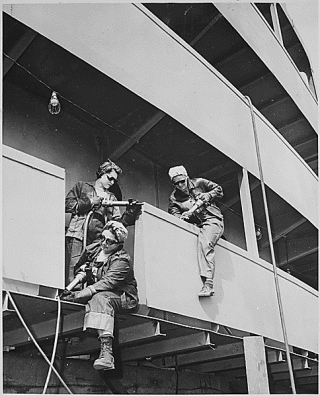
World War II "Chippers"
Companies already engaged in the defense industry expanded their activities and workforce in wartime. Other companies, such as car manufacturers, converted their production lines to manufacture goods for the military. Automakers, such as Ford and General Motors, shifted their output from cars to planes, trucks, and tanks. Throughout the war, the defense industry achieved incredible levels of output including: 2,000,000 trucks, 86,000 tanks and 297,000 aircraft.
Many workers were needed in the defense industry to reach the required output levels. Large numbers of people moved across the country to take up war work. There was a noticeable shift in population as people migrated from rural to urban settings and from the south to the north to take up employment in the defense industry. A large portion of the population had experienced unemployment during the Great Depression. The increase in manufacturing jobs during the war helped greatly reduce the unemployment rate.
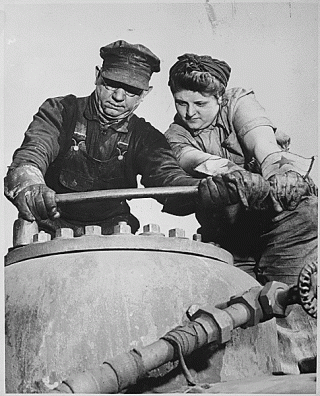
Mechanical helper with the Baltimore & Ohio Railroad
Millions of women were involved in the wartime work force, many of them in the defense industry. There were a variety of female war workers who gained employment in manufacturing during the war. A large number of women shifted from their pre-war employment positions, moving from secretarial or service related jobs to the production line. Other women entered the workforce for the first time.
Women’s motives for taking on such work were varied. Some joined defense plants to patriotically support the country in wartime. Others joined because they had husbands, brothers, or other family members in the military and wished to help support the troops through their employment. Many took jobs in manufacturing because they needed the money. Often these jobs offered women higher wages, then they could obtain in other forms of work such as domestic service or secretarial positions.
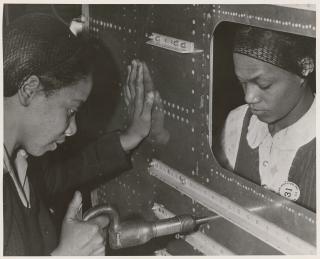
Evelyn T. Gray, Riveter and Pearlyne Smiley, Bucker, complete a section of a bomber
Discrimination and segregation often accompanied the expansion of jobs in the defense industry. Some companies did not want to hired African Americans or employees rebelled against working with African Americans. To remedy the issue, President Roosevelt signed Executive Order 8802, which banned discrimination in the job sector. Despite the regulation, discrimination in factories often continued. Many African Americans were able to obtain jobs in the defense industry. Before the war African American women often worked as domestic servants, performing a wide range of household services from cooking and cleaning to child care. By 1944, African American women in domestic service positions decreased 15.3%, while their employment in defense work increased by 11.5%.
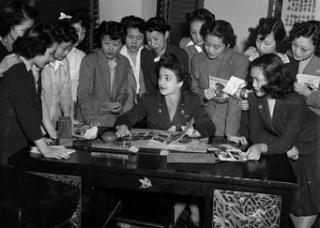
Army Air Forces Air WACs
Chinese American women also found a place in the defense industry. They often faced discrimination in the job market prior to World War II. Regardless of their educational level, many Chinese American and Chinese women were unable to find work outside of their local Chinatowns. However, due to labor shortages during the war, many defense plants welcomed these women into their ranks.
Companies’ views about hiring women were not all the same. Some companies were eager to employ women to replace men, who had joined the military. Other companies, such as Ford, hired women not out of interest, but out of necessity to complete the work. Society held a mixed impression of women in war work, particularly housewives. Female workers were often viewed with suspicion and urged to maintain their domestic and child care responsibilities above all others.
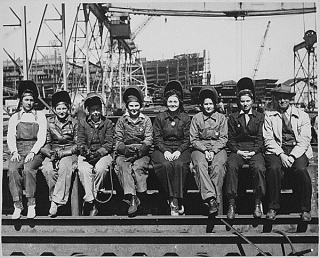
Welders with Shipbuilding Corp, Pascagoula, MS
When the war ended, the employment situation again shifted for women. Some women left employment to reestablish their homes for husbands returning from war. But many women were not given a choice about their employment and were laid-off from their jobs. These women either returned home or sought jobs in other sectors of the economy. Despite the employment of multiple ethnicities in the defense industry during the war, racism and discrimination continued after the conflict concluded.
By Dr. Kelly A. Spring
2017
Discussion Questions:
- What did the government do to boost wartime production in the defense industry?
- Why was the war economically beneficial for the United States?
- Why did women obtain jobs in the defense industry?
- What types of women took up these employment opportunities?
- How did society view these women?
- What happened to women working in the defense industry after the war?
Works Cited:
Articles
Kossoudji, Sherrie A., and Laura J. Dresser. “Working Class Rosies: Women Industrial Workers during World War II.” The Journal of Economic History, 52 (1992): 431-446.
Zhao, Xiaojian. “Chinese American Women Defense Workers in World War II.” California History, 75 (1996): 138-153.
Books
Yellin, Emily. Our Mother’s War: American Women at Home and at the Front During World War II. New York: Simon & Schuster, Inc, 2004.
Online Encyclopedia Entry
McEuen, Melissa A. “Women, Gender, and World War II.” Oxford Research Encyclopedia of American History, June 2016. Accessed July 14, 2017. http://americanhistory.oxfordre.com/view/10.1093/acrefore/9780199329175.001.0001/acrefore-9780199329175-e-55
Websites
PBS. “Brother Can You Spare A Dime?: The Story of Jessie H. Jones.” Accessed August 14, 2017. http://www.pbs.org/jessejones/jesse_ww2_2.htm
PBS. “The War at Home: Civil Rights.” Accessed August 15, 2017. http://www.pbs.org/thewar/at_home_civil_rights_minorities.htm
PBS. “The War at Home: War Production.” Accessed August 14, 2017. http://www.pbs.org/thewar/at_home_war_production.htm
Additional Resources:
Book
Brock, Julia, Dickey, Jennifer W., Harker, Richard J.W., and Catherine M. Lewis (editors). Beyond Rosie: A Documentary History of Women and World War II. Fayetteville: University of Arkansas Press, 2015.
Colman, Penny. Rosie the Riveter: Women Working on the Home Front in World War II. New York: Yearling, 1998.
